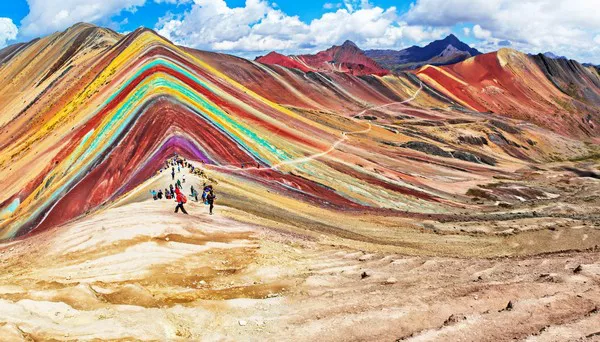The ‘Gringo Trail’ is a term used to describe the route most tourists and backpackers typically take while in South America. Machu Picchu, the Salt Flats of Bolivia and the Christ the Redeemer statue in Rio de Janeiro spring to mind.
While these places are certainly worth visiting, there are so many other amazing places on this nature- and history-rich continent. Here are some of my favourite off the beaten track places to visit in South America.
1. Ischigualasto & Talampaya National Parks, Argentina
Ischigualasto Provincial Park and Talampaya National Park are two contiguous parks covering 275,300ha in the desert region of northwestern Argentina.
Ischigualasto Park is known for its otherworldly rock formations, white crumbly soil and various shades of mineral and sediment striations, giving it a lunar-like landscape and earning it the title of ‘Moon Valley’.
Talampaya Park, on the other hand, is characterised by its majestic red canyons, some as high as 150 metres. Different shades of red paint the walls of the canyons almost in parallel, like an artistic masterpiece.
Both parks have huge geological formations in the shape of mushrooms and submarines. These formations have been carved by wind, water and time.
UNESCO has awarded the contiguous parks World Heritage status because they are hotspots for fossils from the Triassic period, when dinosaurs roamed these lands.
2. Quebrada Las Gachas, Colombia
Quebrada Las Gachas is one of those secret places you don’t want to share. Like an alien formation, Las Gachas is a red, shallow river with numerous plunge pools that you can slide into on your stomach or just soak in like a natural Jacuzzi.
It is a more accessible and much cheaper alternative to the famous Caño Cristales, and unlike the latter, its appearance remains the same throughout the year.
It is a 1 hour walk from the small town of Guadalupe in the province of Santander, Colombia. It’s an easy walk and you’ll hardly see anyone along the way. Most of the people at the river are locals from the area.
As one of them shouted when I found my way there: “Welcome to paradise!”
3. Choquequirao, Peru
The site of Choquequirao is often compared to Machu Picchu; they have a very similar structure and architecture, they served as huge religious, political and economic centres of the Inca Empire, and both cities escaped the Spanish conquistadors.
However, unlike Machu Picchu, Choquequirao receives fewer than 50 visitors a day. The reason for this is its remote location.
To get to Choquequirao you have to trek for 2 days up and down a canyon, up the other side and then another 2 days back. The trek is hot in the day and cold at night, uneventful and extremely steep, but the scenic views of the canyon and rivers make up for it.
You’ll definitely feel a sense of achievement when you enter the ruins of this once glorious city. Choquequirao is said to be bigger than Machu Picchu, but only 30% of it has been excavated.
Shrouded in mist and a challenge to reach, Choquequirao is the true ‘Lost City of the Incas’.
4. Gocta Falls, Peru
Not as famous as Iguazu or Angel Falls, Gocta Falls is an impressive waterfall in the north of Peru. At 771m, it is one of the highest waterfalls in the world.
To reach the base of the falls, you’ll have to hike for 2 hours through dense rainforest from the small town of Cocachimba. You’ll hear the falls before you see them.
The altitude of the Chachapoyas region means that clouds occasionally cover the top of the falls, giving it a mystical feel, while at the bottom the water is ethereal.
The best thing about the Gocta Falls is that, despite their majesty, there are hardly any tourists. You can take pictures without worrying about photobombers.
5. Castle of Lamas, Peru
Far in the north of Peru, Tarapoto is well off the ‘gringo trail’. The city lies in the Amazon cloud forest and is surrounded by waterfalls. But what stands out most is the small town of Lamas, 35 minutes away.
This colourful little town is famous for its European-style medieval castle, which is completely out of place in the Amazon forest. Far from being a cheap replica for children, this 5-storey castle has been painstakingly built with great attention to detail.
Sculptures, carvings and emblems decorate the interior and exterior, making you feel like you’ve stepped back in time to the Renaissance.
Interestingly, the Castillo de Lamas was built by a rich Italian businessman who wanted to build something of great sentimental value. Since then it has been known as ‘the castle that saved the town’ because it created jobs and brought in tourists.


